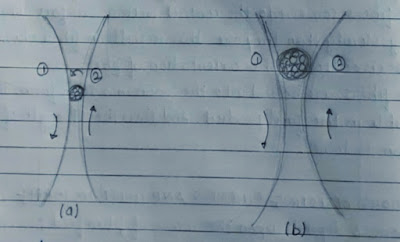Dref
2000 Friction Spinning Process
Yashashree Ingle
Department of Textile
Technology
Veermata Jijabai
Technological Institute, Mumbai, India
General Specification:
- Process group- Open end
- Spinning process- Friction spinning
- Yarn Type- Conventional
- Twist in yarn – True twist
- Yarn strength imparted by mechanical twisting process.
Principle of Friction Spinning:
- This process belong to the open end group because the fiber strand(drawframe sliver) is opened completely to the individual fibers and must be resembled to a new strand (Yarn).
- In Friction spinning the formation of yarn takes place by using suction to bring the individual fibers in to contact with the rotating open end of the yarn which is rotated by the means of perforated drum which has a internal vaccum.
- The yarn formed by means of frictional contact at the drum surface in the convergent region is the continuously withdrawn and wound onto a cross wound package.
- Due to the separate winding unit and twisting we can increase the production.
Working and construction of DREF-2:
Construction:
DREF
2 is generally suited for producing coarse yarns from medium to long staple
cotton. DREF 2 consists of a drafting arrangement, an opening roller, a blower
that lifts of the fibers, fiber cloud , perforated drums, suction unit and open
end yarn.
Working
/ Operating principle:
- The carded sliver is fed to the drafting system. Once the fiber leave the drafting arrangement they are passed in to the main opening roller.
- The drafting arrangement provides a light drafting effect and the drum cloth with saw tooth roller open the strand to individual fiber.
- The separated and individual fibers are then lifted by the blower and forms a fiber cloud which descends towards the pair of perforated drum.
- Now, one suction stream per drum draws the fiber into the convergent region between the drum.
- The open end of the yarn projects into this zone and is also sucked towards the perforated drums. Since this rotates the yarn in the convergent region also rotates.
DREF 2 Yarn characteristics:
- Low Wrapping fibers
- It provides smooth yarn appearance.
- It has optically good mass, evenness and is well suited to knitted goods.
- It is better and softer to handle than that of rotor spun yarn.
Effect of friction spinning process on fiber
orientation:
Yarn
Strength (why the strength of friction spun yarn is low?)
- The fiber come into the contact with the surface which is moving very slowly than they are , this results in fiber buckling and deterioration in the orientation of fiber.
- The fibers are bound into the yarn in a loop form. This effects is visible in the final product. And thus the strength of friction spun yarn is lower.
Factors affecting fineness and twist in yarn:
Fineness
depends on the mass of fiber fed per unit of time and withdrawal speed of yarn.
The
number of turns is determined by the relationship between yarn end revolution
and withdraw speed.
Twist insertion in DREF spun yarn (Factor on
which the transfer of drum rotation to the yarn is dependent in DREF spinning):
- The strand of individual fibers must be take up twist by means by friction on the drums but without the help of high contact pressure on the drums.
- The transfer of rotation to the yarn depends on the coefficient of friction and the contact pressure and both these quantities are difficult to keep constant between spinning position over time, the apparent slip also varies.
- This method of imparting has advantages. In practically all other twisting assemblies one revolution of the twisting element is needed to impart 1 twist in the yarn. But, in friction spinning unlike others , 1 revolution of twisting element can produce several turns of twist. These happens because of the large difference in diameter between the drums and yarn.
Twist transmission in DREF:
- One full drum revolution generates 100 and more yarn turn.
- Considering 2 cases, the twist transmission in DREF 2 can be studied.
- In case A, the yarn with smaller diameter is studied( Fine Yarn), it is noted that the transmission ratio is greater for this type of yarn and fine yarn takes more number of twist that coarse yarn.
- In case B , the diameter of yarn is larger ( coarse yarn), it is noted that the transmission ratio is smaller compare to that of fine yarn and it takes less number twist that fine yarn.
Advantages and Disadvantages of Friction
Spinning:
Advantages:
- High delivery speed.
- Low yarn production cost compare to that of ring spinning.
- Smooth yarn appearance.
- Low wrapping fibers.
Disadvantages:
- Difficulty in keeping spinning conditions constant.
- High air consumption.
- High snarling tendency.
- Low yarn Strength.
Specification of DREF 2000:
- Spinning position per machine= 6 to 64
- Delivery speed= 250 meter/min
- Raw material= Wool, Bast fibers, Synthetic fibers
- Count range= 2000 to 40 Tex
- Feed stock= Card sliver
- Yarn type= Normal Open end yarn
- Yarn characteristics= Woolen spun, Round, Even
- Field of use = Home Textile, Carpets, Blankets, Technical Products.
- Advantage = Elimination of process stage, Spinning waste
- Special Feature= Production of fancy yarn, Core spun yarn.








2 Comments
Cherche machine Dref
ReplyDeletewell explained
ReplyDelete